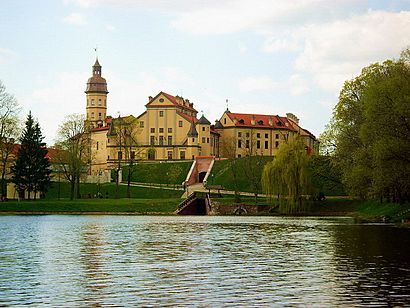Nesvizh Castle facts for kids
| UNESCO World Heritage Site | |
|---|---|

View from the lake
|
|
| Location | Nyasvizh, Minsk Province, Belarus |
| Part of | Architectural, Residential and Cultural Complex of the Radziwill Family at Nesvizh |
| Criteria | Cultural: (ii)(iv)(vi) |
| Inscription | 2005 (29th Session) |
Nesvizh Castle, also known as Niasvizh Castle, is a beautiful old castle in Belarus. It was once the home of the powerful Radziwill family. This family was very important in the history of the region. The castle is a famous example of how people lived and built things long ago. It is now a World Heritage Site, which means it's a special place protected by UNESCO.
Contents
A Home for the Radziwill Family
The Radziwill family, a very rich and powerful family in Belarus, took ownership of the Nesvizh estate in 1533. It was given to Mikołaj Radziwiłł and his brother Jan Radziwiłł. They received it after the Kiszka family, who owned it before, had no more family members.
The Radziwills were one of the most important and wealthy families in the Grand Duchy of Lithuania. This was a large country that existed in Eastern Europe many centuries ago. Because of their importance, the country's main historical records, called the Lithuanian Archive, were moved to Nesvizh in 1551. In 1586, the estate was made into an ordynacja, which was a special type of family property that could not be divided or sold.
Building the Castle
In 1582, a man named Mikołaj Krzysztof "Sierotka" Radziwiłł started building a large, square castle. It had three floors and was completed by 1604. About 50 years later, more sections were added to the castle, including several long hallways called galleries. The castle had four towers with eight sides, one at each corner.
Changes Over Time
In 1706, during a big war called the Great Northern War, the army of Charles XII of Sweden attacked the castle. They damaged it badly and destroyed its defenses. Many years later, the Radziwill family asked architects from Germany and Italy to fix and make the castle bigger.
An artist named Antoni Zaleski decorated the castle's yellow walls with fancy designs made of stucco. Stucco is a type of plaster used for decoration. The old castle gates from the 16th century were also rebuilt. At this time, three separate buildings around the main courtyard were joined together to form one large structure.
The Church and Family Tombs
A very important building in Nesvizh is the Corpus Christi Church. It is connected to the castle by a bridge over a ditch. This church is special because it holds the coffins of 72 members of the Radziwill family. Each coffin is simple, made of birch wood, and marked with the family's coat of arms.
The church was designed by an Italian architect named Gian Maria Bernardoni. It is believed to be the first church built by the Jesuits (a religious group) that looked like the famous Il Gesù church in Rome. It was also the first church in the world with a dome and a Baroque style front. It was the first Baroque building in Eastern Europe.
Later Years and Restoration
In 1770, Russian forces took over the castle. The Radziwill family had to leave. The important Lithuanian Archive was moved to Saint Petersburg, where it still is today. Many valuable artworks from the palace were given to different Russian noble families.
After the Russian army left, the palace slowly started to fall apart. But the Radziwills eventually got it back and began to fix it. Between 1881 and 1886, Prince Anton Radziwill and his French wife, Marie de Castellane, repaired the inside of the castle. They also created a huge park in the English style. This park covers more than one square kilometer, making it one of the largest in Europe.
In 1939, the Radziwill family was again forced to leave the castle by the Red Army. During the time of the Soviet Union, the castle was used as a sanatorium, which is a place where people go to rest and get better when they are sick.
In 1994, the castle complex was made a national historical and cultural reserve. This means it is a protected site important to the country's history and culture. Twelve years later, in 2005, the castle complex was added to the World Heritage List.
Images for kids
See also
 In Spanish: Palacio de Nesvizh para niños
In Spanish: Palacio de Nesvizh para niños




